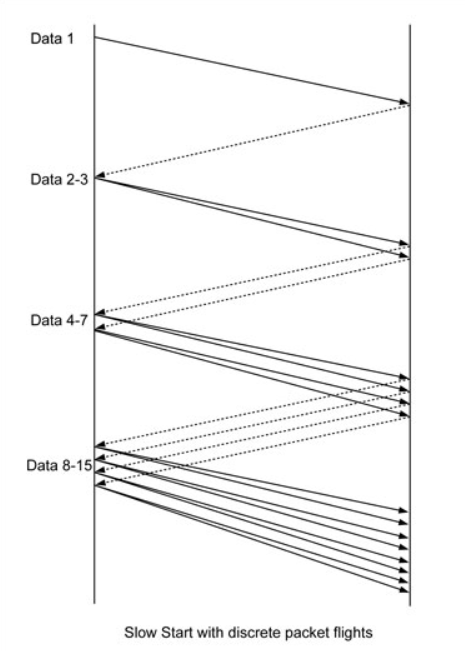Question
Consider the following network, with each link other than the first having a bandwidth delay of 1 packet/second. Assume ACKs travel instantly from B to
Consider the following network, with each link other than the first having a bandwidth delay of 1 packet/second. Assume ACKs travel instantly from B to R (and thus to A). Assume there are no propagation delays, so the RTTnoLoadis 4; the bandwidthRTT product is then 4 packets. If A uses sliding windows with a window size of 6, the queue at R1 will eventually have size 2.
Suppose A usesthresholdslow start withssthresh= 6, and withcwndinitially 1. Complete the table below until two rows aftercwnd= 6; for these final two rows,cwndhas reachedssthreshand so A will send only one new packet for each ACK received.
How big will the queue at R1 grow?
| T | A sends | R1 queues | R1 sends | B receives/ACKs | cwnd |
|---|---|---|---|---|---|
| 0 | 1 | 5 | 1 | 1 | 1 |
| 1 | |||||
| 2 | |||||
| 3 | |||||
| 4 | 2,3 | 3 | 2 | 1 | 2 |
| 5 | 3 | 2 | |||
| 6 | |||||
| 7 | |||||
| 8 | 4,5 | 5 | 4 | 2 | 3 |
Note that if, instead of using slow start, A simply sends the initial windowful of 6 packets all at once, then the queue at R1 will initially hold 6-1 = 5 packets.
2.0. Consider the following network from13.2.3Slow-Start Multiple Drop Example, with links labeled with bandwidths in packets/ms. Assume ACKs travel instantly from B to R (and thus to A).
A---infinitely fast---- R ----1 pkt/ms----B
A begins sending to B using unbounded slow start, beginning with Data[1] at T=0. Write out a table of packet transmissions and deliveries assuming R's queue size is 5 (not counting the packet currently being forwarded). Stop with the arrival at A of the first dupACK triggered by the arrival at B of the packet that followed the first packet that was dropped by R. No retransmissions will occur by then.
3.0. Consider the network from exercise 2.0 above. A again begins sending to B using unbounded slow start, but this time R's queue size is 2, not counting the packet currently being forwarded. Make a table showing all packet transmissions by A, all packet drops by R, and other columns as are useful. Assume noretransmission mechanism is used at all (no timeouts, no fast retransmit), and that A sends new data only when it receives new ACKs (dupACKs, in other words, do not trigger new data transmissions). With these assumptions, new data transmissions will eventually cease; continue the table until all transmitted data packets are received by B.
4.0. Suppose TCP Reno is used to transfer a large file over a path with bandwidth high enough that, during slow start,cwndcan be treated as doubling each RTT as in13.2Slow Start. Assume the receiver places no limits on window size.

Data 1 Data 2-3 Data 4-7 Data 8-15 Slow Start with discrete packet flights
Step by Step Solution
There are 3 Steps involved in it
Step: 1

Get Instant Access to Expert-Tailored Solutions
See step-by-step solutions with expert insights and AI powered tools for academic success
Step: 2

Step: 3

Ace Your Homework with AI
Get the answers you need in no time with our AI-driven, step-by-step assistance
Get Started


